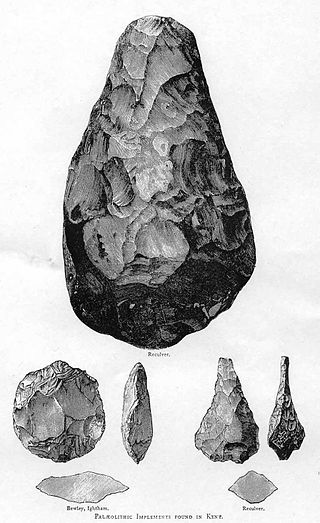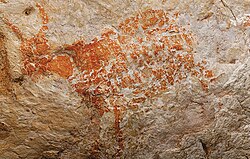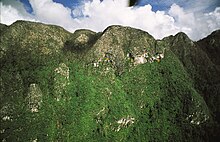
Borneo is the third-largest island in the world, with an area of 748,168 km2 (288,869 sq mi). Situated at the geographic centre of Maritime Southeast Asia, it is one of the Greater Sunda Islands, located north of Java, west of Sulawesi, and east of Sumatra.

The history of painting reaches back in time to artifacts and artwork created by pre-historic artists, and spans all cultures. It represents a continuous, though periodically disrupted, tradition from Antiquity. Across cultures, continents, and millennia, the history of painting consists of an ongoing river of creativity that continues into the 21st century. Until the early 20th century it relied primarily on representational, religious and classical motifs, after which time more purely abstract and conceptual approaches gained favor.

Sulawesi, also known as Celebes, is an island in Indonesia. One of the four Greater Sunda Islands, and the world's 11th-largest island, it is situated east of Borneo, west of the Maluku Islands, and south of Mindanao and the Sulu Archipelago. Within Indonesia, only Sumatra, Borneo, and Papua are larger in territory, and only Java and Sumatra are more populous.

In archaeology, cave paintings are a type of parietal art, found on the wall or ceilings of caves. The term usually implies prehistoric origin. These paintings were often created by Homo sapiens, but also Denisovans and Neanderthals; other species in the same Homo genus. Discussion around prehistoric art is important in understanding the history of the Homo sapiens species and how Homo sapiens have come to have unique abstract thoughts. Some point to these prehistoric paintings as possible examples of creativity, spirituality, and sentimental thinking in prehistoric humans.

In the history of art, prehistoric art is all art produced in preliterate, prehistorical cultures beginning somewhere in very late geological history, and generally continuing until that culture either develops writing or other methods of record-keeping, or makes significant contact with another culture that has, and that makes some record of major historical events. At this point ancient art begins, for the older literate cultures. The end-date for what is covered by the term thus varies greatly between different parts of the world.

East Kalimantan is a province of Indonesia. Its territory comprises the eastern portion of Borneo. It had a population of about 3.03 million at the 2010 census, 3.42 million at the 2015 census, and 3.766 million at the 2020 census; the official estimate as at mid 2023 was 4,030,488. Its capital is the city of Samarinda.

The Aurignacian is an archaeological industry of the Upper Paleolithic associated with Early European modern humans (EEMH) lasting from 43,000 to 26,000 years ago. The Upper Paleolithic developed in Europe some time after the Levant, where the Emiran period and the Ahmarian period form the first periods of the Upper Paleolithic, corresponding to the first stages of the expansion of Homo sapiens out of Africa. They then migrated to Europe and created the first European culture of modern humans, the Aurignacian.

Figurative art, sometimes written as figurativism, describes artwork that is clearly derived from real object sources and so is, by definition, representational. The term is often in contrast to abstract art:
Since the arrival of abstract art the term figurative has been used to refer to any form of modern art that retains strong references to the real world.

The Bacho Kiro cave is situated 5 km (3.1 mi) west of the town Dryanovo, Bulgaria, only 300 m (980 ft) away from the Dryanovo Monastery. It is embedded in the canyons of the Andaka and Dryanovo River. It was opened in 1890 and the first recreational visitors entered the cave in 1938, two years before it was renamed in honor of Bulgarian National Revival leader, teacher and revolutionary Bacho Kiro. The cave is a four-storey labyrinth of galleries and corridors with a total length of 3,600 m (11,800 ft), 700 m (2,300 ft) of which are maintained for public access and equipped with electrical lights since 1964. An underground river has over time carved out the many galleries that contain countless stalactone, stalactite, and stalagmite speleothem formations of great beauty. Galleries and caverns of a 1,200 m (3,900 ft) long section have been musingly named as a popular description of this fairy-tale underground world. The formations succession: Bacho Kiro’s Throne, The Dwarfs, The Sleeping Princess, The Throne Hall, The Reception Hall, The Haidouti Meeting-Ground, The Fountain and the Sacrificial Altar.
Paleolithic Europe, or Old Stone Age Europe, encompasses the Paleolithic or Old Stone Age in Europe from the arrival of the first archaic humans, about 1.4 million years ago until the beginning of the Mesolithic around 10,000 years ago. This period thus covers over 99% of the total human presence on the European continent. The early arrival and disappearance of Homo erectus and Homo heidelbergensis, the appearance, complete evolution and eventual demise of Homo neanderthalensis and the immigration and successful settlement of Homo sapiens all have taken place during the European Paleolithic.

East Kutai Regency is a regency of East Kalimantan province, Indonesia. It has an area of 31,239.84 km2 and had a population of 253,904 at the 2010 census and 434,459 at the 2020 census; the official estimate as at mid 2023 was 455,504. The town of Sangatta is the capital of the regency.

Painting is a visual art, which is characterized by the practice of applying paint, pigment, color or other medium to a solid surface. The medium is commonly applied to the base with a brush, but other implements, such as knives, sponges, and airbrushes, may be used.

The oldest undisputed examples of figurative art are known from Europe and from Sulawesi, Indonesia, dated about 35,000 years old . Together with religion and other cultural universals of contemporary human societies, the emergence of figurative art is a necessary attribute of full behavioral modernity.

The art of the Upper Paleolithic represents the oldest form of prehistoric art. Figurative art is present in Europe and Southeast Asia, beginning between about 40,000 to 35,000 years ago. Non-figurative cave paintings, consisting of hand stencils and simple geometric shapes, are somewhat older, at least 40,000 years old, and possibly as old as 64,000 years. This latter estimate is due to a controversial 2018 study based on uranium-thorium dating, which would imply Neanderthal authorship and qualify as art of the Middle Paleolithic.

Prehistoric Indonesia is a prehistoric period in the Indonesian archipelago that spanned from the Pleistocene period to about the 4th century CE when the Kutai people produced the earliest known stone inscriptions in Indonesia. Unlike the clear distinction between prehistoric and historical periods in Europe and the Middle East, the division is muddled in Indonesia. This is mostly because Indonesia's geographical conditions as a vast archipelago caused some parts — especially the interiors of distant islands — to be virtually isolated from the rest of the world. West Java and coastal Eastern Borneo, for example, began their historical periods in the early 4th century, but megalithic culture still flourished and script was unknown in the rest of Indonesia, including in Nias and Toraja. The Papuans on the Indonesian part of New Guinea island lived virtually in the Stone Age until their first contacts with modern world in the early 20th century. Even today living megalithic traditions still can be found on the island of Sumba and Nias.

The caves in the Maros-Pangkep karst are situated in South Sulawesi, Indonesia, and contain paintings from the Paleolithic considered to be the earliest figurative art in the world, dated to at least 43,900 years ago.

It is quite difficult to define Indonesian art, since the country is immensely diverse. The sprawling archipelago nation consists of 17.000 islands. Around 922 of those permanently inhabited, by over 1,300 ethnic groups, which speak more than 700 living languages.

Indonesian painting has a very long tradition and history in Indonesian art, though because of the climatic conditions very few early examples survive, Indonesia is home to some of the oldest paintings in the world. The earliest Indonesian paintings were the rock paintings of prehistoric times, such as the petroglyphs found in places like in the caves in the district of Maros in Sulawesi, Indonesia. The Stone Age rock paintings found in Maros Cave are approximately 40,000 years old and are listed as one of the oldest paintings in the world.
Cape Mangkalihat, also known as Cape Sangkulirang, is a cape in eastern Borneo. It is located in the Indonesian province of East Kalimantan, in the regencies of Berau and East Kutai.


















